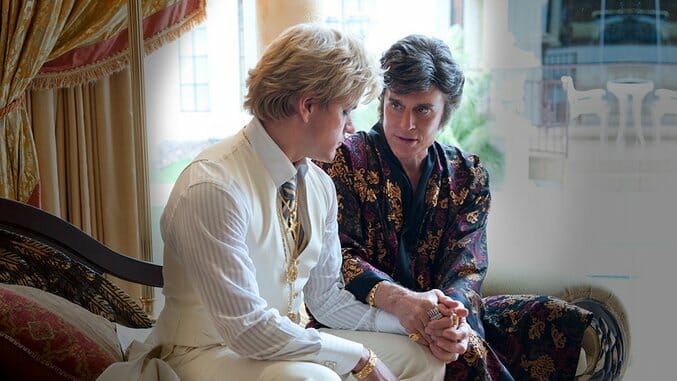
At first blush, the main draw of Behind the Candelabra would seem to be its camp appeal: a true-life love story between a humble aspiring veterinarian and Liberace, that icon of kitsch and knowing excess. And while that element exists in director Steven Soderbergh’s film, what resonates more strongly is the difficulty in falling in love with someone famous. That person may love you back sincerely, but fame always gets in the way. That’s not a particularly revelatory idea, but Soderbergh and his cast at least find a lively way to say it one more time.
Based on the book by Scott Thorson and Alex Thorleifson, Behind the Candelabra traces about 10 years in the relationship between Thorson (Matt Damon) and Liberace (Michael Douglas). They first meet in the mid-1970s when a friend of Thorson’s takes him backstage after a Liberace show, an immediate spark developing between the two men, despite the major age difference. Soon, Liberace has invited Thorson to move in, hiring him as an assistant and right-hand man, although Thorson’s principal occupation is really as boyfriend.
Douglas and Damon make for a convincing gay couple, with the dynamic of their characters’ relationship established early on. Scott takes care of Liberace and adores him, while Liberace treats the much younger man as a lover, friend, employee—even a son. (At one point in their time together, Liberace met with lawyers about legally adopting him, no doubt appealing for Thorson, who grew up in foster homes and never really had a father.) It’s a loving, committed relationship, but it’s clear it’s also an imbalanced one. Early on in the film, a houseboy warns the wide-eyed Thorson that other young studs have come and gone through Liberace’s orbit. It’s not a question of their love lasting—it’s merely a matter of when it will end.
The poignancy of that grim certainty exists throughout Behind the Candelabra—it’s even stronger if you know the real story and how it ends up—but Soderbergh spends most of the movie putting us in the mindset of Thorson, who desperately doesn’t want it to be true. As a result, the story plays like a kooky romance, and not because they’re gay. While there is a little wink-wink humor directed at the characters’ sexual preference that’s never homophobic but perhaps more than a touch sophomoric, Soderbergh’s best running joke is that this rather bizarre relationship, at least from the outside, seemed completely normal to Liberace and Thorson. (Those close to Liberace called him Lee, as if a man wearing ridiculous suits and an incredibly fake wig could ever be as ordinary as a “Lee.”)
Making this eccentric love affair seem conventional is the principal job of the two actors, and with a few disappointing exceptions, they don’t try to oversell their characters’ homosexuality for cheap laughs. Douglas raises his voice some to match Liberace’s preening delivery, but he grounds the performance in the musician’s sense of theatrics. Watching Behind the Candelabra, you get the sense that Liberace couldn’t really tell the difference between playing on stage and playing in real life. It’s all a construction of sorts, but one Liberace believed in utterly. (He went to his grave a devout Catholic, even having an answer for why God would forgive his sexuality when his Church wouldn’t.)
By the time Thorson becomes part of Liberace’s world, Liberace is already a wealthy institution, already on his way to becoming a self-mocking parody of an entertainer rather than a real person. But Thorson doesn’t quite see that, and neither does Liberace, and so Soderbergh follows suit: His typically cool directing style simply re-creates this environment without necessarily judging it. And with Thorson as our surrogate, Damon (with his open, kind face) makes us understand why this sweet, nice guy would fall so head over heels for Liberace. The movie suggests that Thorson, because of his run of foster families as a kid, really doesn’t have a sense of home. Liberace, always so loving and supportive, provides him with one, and that (combined with the fabulous riches and fame) are simply too much to resist.
Of course, the riches and fame were never Thorson’s—they belonged to Liberace. It’s a hard lesson that eventually Thorson is going to learn, and Behind the Candelabra can be somewhat predictable in its rise-then-fall biopic construction. But in this case, it’s not the star who has the high highs and low lows—it’s really Thorson. A glitzy coming-of-age story told in hot tubs and Rolls Royces, Behind the Candelabra is not necessarily the sort of project you envision Soderbergh finishing his directing career making. (If he, in fact, retires, which is still too difficult to believe.) But if it is his final movie, it’s worth noting that this is one of his warmest. Love stories haven’t been a big focus in his work. But Behind the Candelabra’s sympathetic portrait of Liberace and Thorson casts them as two very different outsiders who found each other. It didn’t last. But as the movie’s ending argues, maybe in some ways for both men, it did.
Director: Steven Soderbergh
Writers: Richard LaGravenese (screenplay); Scott Thorson, Alex Thorleifson (book)
Starring: Michael Douglas, Matt Damon, Rob Lowe, Dan Aykroyd, Scott Bakula, Debbie Reynolds
Release Date: Screening in the Official Competition at the 2013 Cannes Film Festival